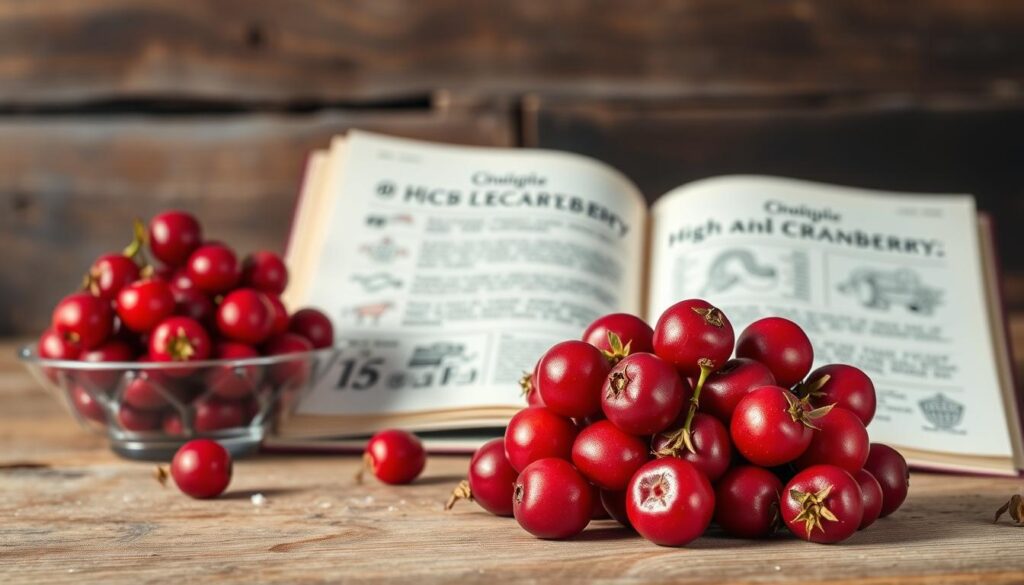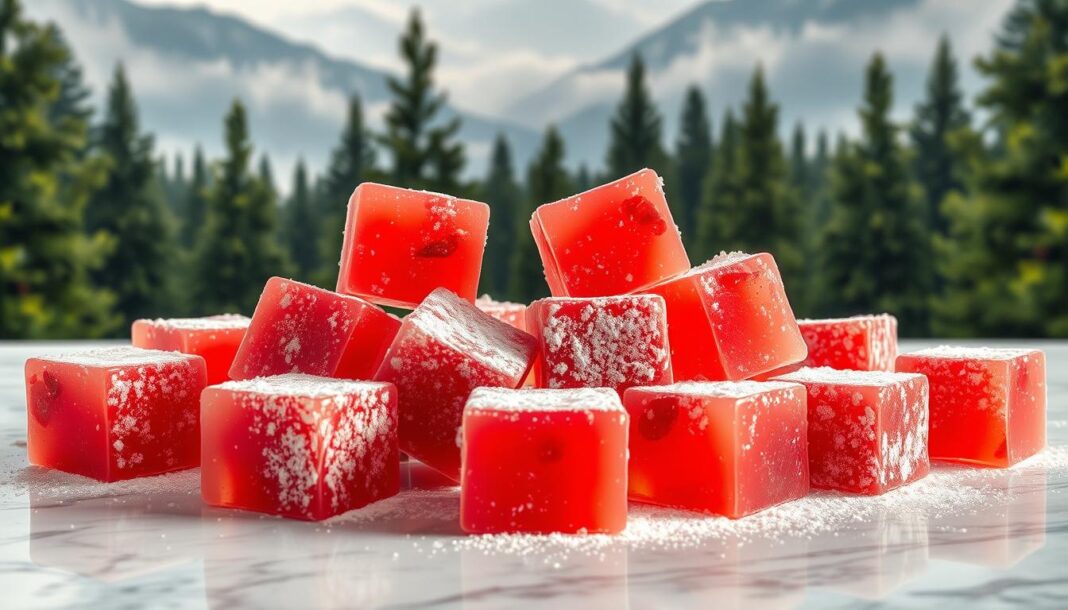Cranberries are a nutritional powerhouse, loaded with antioxidants and offering numerous health benefits, from preventing urinary tract infections to boosting the immune system. When cooked, fresh cranberries transform, releasing their tart juices and developing a complex sweetness.
We explore the tradition of cooking cranberries on the stove, a simple yet rewarding skill that produces vibrant, flavorful results. By understanding the science behind cooking cranberry sauce—how heat breaks down the fruit’s cell walls and releases natural pectins—we can achieve that perfect gel-like consistency. For more creative ideas, check out our guide on fried cranberries.
Mastering stovetop cranberry cooking is an essential skill for any home cook, whether you’re preparing a traditional sauce for holiday meals or exploring new recipes using fresh cranberries.
The History and Health Benefits of Cranberries
The history of cranberries is rich and diverse, spanning centuries and offering insights into their traditional uses and health benefits. For years, cranberries have been a part of various cultural practices, particularly in American cuisine, where they were valued not only for their taste but also for their medicinal properties.
Traditional Uses of Cranberries in American Cuisine
Cranberries have been traditionally used in American cuisine in a variety of dishes, from sauces and relishes to baked goods and beverages. Their unique flavor and nutritional benefits made them a staple ingredient, especially during holidays like Thanksgiving. We have seen cranberry sauce become a traditional accompaniment to roasted turkey, adding a burst of flavor to the meal.
Nutritional Profile and Health Benefits
Cranberries are exceptionally rich in bioactive compounds that support human health. They contain five times more antioxidants than broccoli, which helps combat oxidative stress and inflammation. The unique A-type proanthocyanidins in cranberries prevent bacteria from adhering to the urinary tract lining, thus preventing urinary tract infections. Over the years, research has established that cranberries contribute to cardiovascular health by improving circulation and lowering LDL cholesterol levels.
| Nutrient | Amount per 100g | Health Benefit |
|---|---|---|
| Antioxidants | High | Combats oxidative stress and inflammation |
| Fiber | 4.6g | Supports digestive health |
| Vitamin C | 10.3mg | Boosts immune system |

Modern nutritional science has confirmed the health benefits of cranberries, which have been valued for years. Their low sugar content and high fiber make them a nutritionally dense food, providing substantial health benefits with relatively few calories. As we continue to explore the uses of cranberries, it’s clear that their nutritional profile makes them a valuable addition to a healthy diet.
Selecting and Preparing Fresh Cranberries
To ensure your cranberry recipes turn out their best, it’s crucial to understand how to pick and prepare fresh cranberries. The quality of your final dish heavily relies on the freshness and quality of the cranberries you start with.
How to Choose Quality Cranberries
When selecting fresh cranberries, look for berries that are firm, plump, and have a vibrant red color. Avoid cranberries that are soft, shriveled, or discolored, as these are signs of spoilage.
Here’s a simple guide to choosing quality cranberries:
| Characteristic | Good Quality | Poor Quality |
|---|---|---|
| Color | Vibrant red | Dull, discolored |
| Texture | Firm, plump | Soft, shriveled |
Proper Washing and Sorting Techniques
Begin the preparation process by emptying your bag of cranberries into a colander and rinsing them thoroughly under cool running water. This step is crucial for removing any residual dirt or agricultural residues.
- Rinse fresh cranberries before using them.
- Discard any cranberries that look squashed, browned, or otherwise spoiled.
- After rinsing, spread the cranberries on a clean kitchen towel or paper towels and inspect them carefully, removing any stems, leaves, or debris.

For recipes requiring chopped cranberries, we recommend washing and sorting first, then patting them completely dry before chopping to prevent excessive moisture from affecting your recipe.
How to Cook Cranberries on the Stove
Achieving the ideal cranberry sauce requires attention to detail during the stovetop cooking process. We will guide you through creating a delicious cranberry sauce from scratch.
Basic Cranberry Sauce Recipe
To start, you’ll need a simple cranberry sauce recipe that serves as a foundation for various flavor adjustments. Combine 12 oz (3 cups) of fresh or frozen cranberries with 1 cup of granulated sugar and 1/4 cup of water in a medium saucepan. This recipe makes about 2 cups of sauce, perfect for topping your holiday dishes.
For those who prefer a more intense flavor, you can adjust the sugar level or add other ingredients like orange zest or cinnamon sticks to create a unique twist on the traditional cranberry sauce.
Step-by-Step Cooking Process
To cook your cranberry mixture, place the saucepan over medium heat and bring to a simmer. Cook uncovered for 4-5 minutes, stirring occasionally, until the mixture becomes foamy and the popping of cranberries slows down. The sauce will thicken as it cools due to the natural pectins released during cooking.
The longer you simmer the sauce, the smoother it becomes. For a chunkier consistency, similar to a pie filling, boil for closer to 5 minutes. This flexibility allows you to customize the texture to your liking.
How to Tell When Cranberries Are Perfectly Cooked
Perfectly cooked cranberries exhibit several visual and auditory cues. The popping sounds will diminish significantly, the mixture will develop a foamy appearance, and approximately 75% of the berries will have burst open. You can also perform a consistency test by drawing your spoon through the mixture; it should leave a momentary path before slowly filling in.
- The color transformation is another indicator – perfectly cooked cranberry sauce develops a deep, translucent ruby-red color.
- Cooking time significantly affects the texture, with shorter periods producing a chunkier sauce and longer simmering creating a smoother consistency.
- Remember, cranberry sauce continues to thicken as it cools, so remove it from heat when it appears slightly thinner than your desired final consistency.
Flavor Variations and Additions
The versatility of cranberry sauce lies in its ability to be customized with numerous flavor variations, making it a versatile condiment for any meal. By incorporating different spices, fruits, and other ingredients, we can transform this traditional sauce into a unique culinary creation.
Classic Orange and Cinnamon Cranberry Sauce
A traditional cranberry sauce recipe often includes the warmth of cinnamon and the brightness of orange juice. To make this classic version, we combine fresh cranberries with cinnamon sticks, the juice of one orange, and sugar, then cook them in water. The orange peels can also be added to the pot for extra flavor. This combination results in a cranberry sauce that is both familiar and comforting.
Adjusting Sweetness Levels
The sweetness of cranberry sauce can be adjusted to suit any taste. For a less sweet sauce, reduce the amount of sugar or substitute it with a natural sweetener like honey. Conversely, for a sweeter sauce, add more sugar or try using sweeter fruits like orange or pineapple juice.
Creative Spice and Flavor Combinations
Beyond the classic orange-cinnamon combination, cranberry sauce welcomes a remarkable range of spices and flavorings. Warm spice blends, such as cinnamon, nutmeg, and clove, create a holiday-inspired profile. For an exotic twist, try combining cardamom, ginger, and star anise. Incorporating complementary fruits like diced pears or apples adds complexity and texture. For adult variations, a splash of port wine or Grand Marnier during the final minute of cooking can add depth without overwhelming the cranberry flavor.
| Flavor Combination | Description | Recommended For |
|---|---|---|
| Cinnamon, Nutmeg, Clove | Warm, spicy, and aromatic | Holiday meals |
| Cardamom, Ginger, Star Anise | Exotic, sweet, and spicy | Special occasions |
| Pear or Apple Addition | Fruity, complex, and textured | Family gatherings |
Troubleshooting Common Cranberry Cooking Issues
Even experienced cooks can encounter issues when preparing cranberry sauce, but understanding how to troubleshoot common problems can make all the difference. Whether you’re adjusting the flavor or dealing with consistency, we’ve got you covered.
Fixing Overly Tart or Sweet Sauces
Balancing the sweetness and tartness of cranberry sauce is crucial. If your sauce is too tart, you can add a bit more sugar or try using alternative sweeteners like honey or maple syrup to taste. Conversely, if it’s too sweet, adding a splash of lemon juice or orange zest can help restore balance.
Achieving the Perfect Consistency
The ideal cranberry sauce should be thick enough to hold its shape but still be saucy. If your sauce is too runny, simmering it for a few extra minutes can help reduce the liquid. For a sauce that’s too thick, a small amount of water or juice can be added to achieve the desired consistency.
| Issue | Solution |
|---|---|
| Too Tart | Add sugar or alternative sweeteners |
| Too Sweet | Add lemon juice or orange zest |
| Too Runny | Simmer to reduce liquid |
| Too Thick | Add water or juice |
Using Frozen Cranberries Instead of Fresh
Frozen cranberries are a convenient alternative to fresh ones, especially off-season. When using frozen cranberries, there’s no need to thaw them first; simply add them directly to your saucepan. Keep in mind that frozen cranberries may release more liquid during cooking, so be prepared to simmer the sauce a bit longer to achieve the desired thickness. Choosing high-quality frozen cranberries without visible ice crystals ensures the best flavor and texture.
Creative Ways to Use Cooked Cranberries
With cooked cranberries on hand, you can explore a variety of creative ways to incorporate them into your cooking and baking. Cooked cranberries are a versatile ingredient that can enhance both savory dishes and sweet treats, making them a valuable addition to your culinary repertoire.
Pairing with Savory Dishes
Cooked cranberries can be paired with savory dishes to create a striking contrast of flavors. They complement roasted meats and vegetables exceptionally well. For instance, a cranberry sauce can be served alongside roasted turkey or used as a topping for savory scones or biscuits. The tartness of the cranberries cuts through the richness of the meal, creating a balanced flavor profile.
Incorporating into Baked Goods
Incorporating cooked cranberries into baked goods is another excellent way to utilize them. They can be added to muffin, scone, or bread recipes to introduce a burst of flavor and moisture. Cranberry pie is a classic dessert that showcases the fruit’s potential in baking. You can also make a delicious cranberry cream pie by incorporating whipped cream into the filling.
Roasting Cranberries with Vegetables
Roasting cranberries alongside fall and winter vegetables like hard squash, sweet potatoes, or Brussels sprouts creates a delightful sweet-tart contrast. To do this, toss 2-3 pounds of your chosen vegetables with 1 cup of fresh cranberries, 1-2 tablespoons of olive oil, salt, and pepper. Add optional ingredients like cinnamon, nutmeg, or maple syrup to taste. Roasting caramelizes the natural sugars in both the cranberries and vegetables, intensifying flavors and creating a delightful textural contrast.
For a complete presentation, consider garnishing your roasted cranberry-vegetable combinations with complementary elements like crumbled feta cheese or chopped nuts. This adds a creamy richness and crunch that balances the tartness of the cranberries.
Storing and Preserving Your Cranberry Creations
Cranberry sauce is a versatile condiment that can be enjoyed throughout the year with proper storage and preservation techniques. We recommend making a batch a few days in advance to allow the flavors to meld together.
To store your cranberry sauce, simply cover the bowl with plastic wrap or transfer it to an airtight container and refrigerate. Fresh cranberry sauce can be stored in the fridge for 7-10 days or frozen for up to a month. When refrigerating, make sure to leave some headspace for expansion.
For longer preservation, consider freezing or traditional canning methods. Cranberry sauce freezes exceptionally well for up to 3 months. You can portion it into smaller containers or ice cube trays for convenient future use. When you’re ready to use it, allow the frozen sauce to thaw gradually in the refrigerator over 24-48 hours.
By storing your cranberry creations properly, you can enjoy them well beyond the initial preparation, making the most of your culinary efforts throughout the year.


